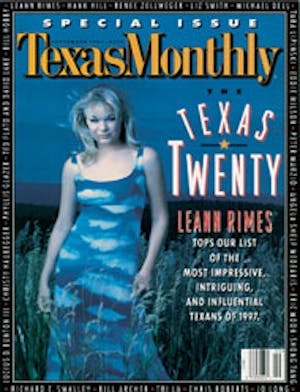“PLANTS PRODUCE BLOOMS with excess energy,” says Jo Long. She’s expounding on her favorite hobby, gardening, but the words could just as well refer to San Antonio’s Carver Community Cultural Center, which has flowered under two decades of Long’s leadership. Thanks to her fertile mind, the Carver has not only strengthened its role as a center of black neighborhood life butby hosting the likes of the New York City Opera, the Alvin Ailey Dance Company, and the avant-garde percussion group Stompit has also cultivated a reputation as the city’s liveliest, most ambitious sponsor of the performing arts.
A native of Lubbock (which she dubs Home of the Very Bad Weather Story), the 47-year-old Long grew up as the eldest child in a close-knit family in an equally close-knit (and segregated) neighborhood. Her parents, who ran a cafe and motel, sent their children to a black private school through the eighth grade. Long excelled academically and musically; by high school she had learned to play clarinet, oboe, piano, and tenor sax. (A love of music runs in her family; her great-uncle Huey Long was a member of the Ink Spots.)
Her sheltered upbringing continued at Dallas’ Bishop College, a strict, all-black Baptist school. Then she enrolled in graduate school at Southern Methodist University, where the unstructured lifestyle created culture shock. “I realized I was definitely a hick,” she says. “I had always kept my mind on my studies, and I was unprepared for big-city life. I wasn’t even sure what all that Martin Luther King stuff wasin Lubbock there hadn’t been any big exposs about civil rights.” Later, questioning her parents about racism, she recalls, “My mother said, We didn’t want you to know that you were hated and despised. We wanted you to think you could do anything.’ And that,” she states firmly, “was the beginning of my knowing.”
Long set out to reconcile her supportive, segregated life in West Texas with the unsettling racial injustices encountered in Big D. She volunteered for a variety of South Dallas organizations with social agendas and worked for an SMU dean who directed a community arts center. The combined experiences made her a top choice when, at the age of 26, the city-appointed Carver advisory board tapped her to revitalize the east-side center, which since 1905 had served as an all-purpose meeting house for the city’s black families. Traditionally operated as a segregated center, it had languished in the wake of integration and had even teetered on the brink of demolition; a long-overdue restoration was nearing completion when Long arrived in 1976.
“My original assignment was to develop a nice little arts and crafts program,” she says with a wry smile. Instead, she walked into a maelstrom. “There was a large disagreement among board members over whether the Carver should be city-owned or independent and nonprofit. The argument had enraged people.” But Long possesses considerable persuasive powers. Unruffled, she forged a compromise and eventually a strong alliance between the two groups that buoys the Carver to this day.
Her low-key charmand her refusal to take no for an answeralso helped her persuade arts groups to commit the money required to import international stars of dance, classical music, theater, and song. “Oftentimes, in Texas and San Antonio, I’m struck by how people’s standards are so low,” she says. “What is good is considered superlative. Why not aim for superlative in the first place?” She was so successful at luring prestigious names that many events quickly outgrew the 650-seat Carver, requiring relocation to more- spacious venues such as Trinity University’s 2,000-seat Laurie Auditorium. Currently Long is casting about for a place that can accommodate the New York City Opera, which will stage Madame Butterfly in San Antonio in 1999. (That year will also mark the Carver-sponsored local debut of the New York Philharmonic.) Besides actual hall space, she also begs, borrows, and rents equipment and expertise to meet ever-tougher production standards. Meanwhile, in a revival of its traditional role, the Carver is booked solid for miscellaneous small-scale gatheringsgraduations, pageants, parties, and the like.
Long thrives on challenges in her personal life too. She lives within walking distance of the Carver in an 1860’s limestone house that she bought three years ago “as a shellno plumbing or electricity, no doors or windows.” She not only completed the house but also transformed it with refinished hardwood floors and walls boldly painted eggplant purple, sunshine yellow, and midnight blue. Her current goal: transforming her weed-choked three-quarter-acre lot into the ambitious path-laced garden designed for her by Eric Lautzenheiser, the former head of the San Antonio Botanical Center.
Although Long has already landscaped the Carver, both literally and figuratively, she asserts that there is always room for improvement. “I’m glad people talk about all the Carver has done,” she allows. “And I do think the Carver has done well. But I haven’t met my expectations yet. We can do even better.”
- More About:
- San Antonio







